Introduction to Finance: EOQ, Investment Appraisal, and Ratios
VerifiedAdded on 2023/01/06
|16
|4022
|90
Homework Assignment
AI Summary
This finance assignment delves into core financial concepts and techniques. It begins with the calculation of the Economic Order Quantity (EOQ) and total annual costs, critically evaluating the EOQ model's application for a sports equipment company, and offering advice on inventory management. The assignment then proceeds to investment appraisal, calculating the payback period and Accounting Rate of Return (ARR) for two investment options, critically assessing the ARR technique, and discussing characteristics of investment appraisal decisions and the advantages/disadvantages of the Internal Rate of Return (IRR) technique. It also covers financial statement analysis, including the calculation and interpretation of financial ratios, and the importance of considering the audience for financial statement analysis. Finally, the assignment explores the roles of various financial organizations and critically discusses the role of audit committees in corporate governance. The assignment provides a comprehensive overview of financial planning, analysis, and decision-making processes.
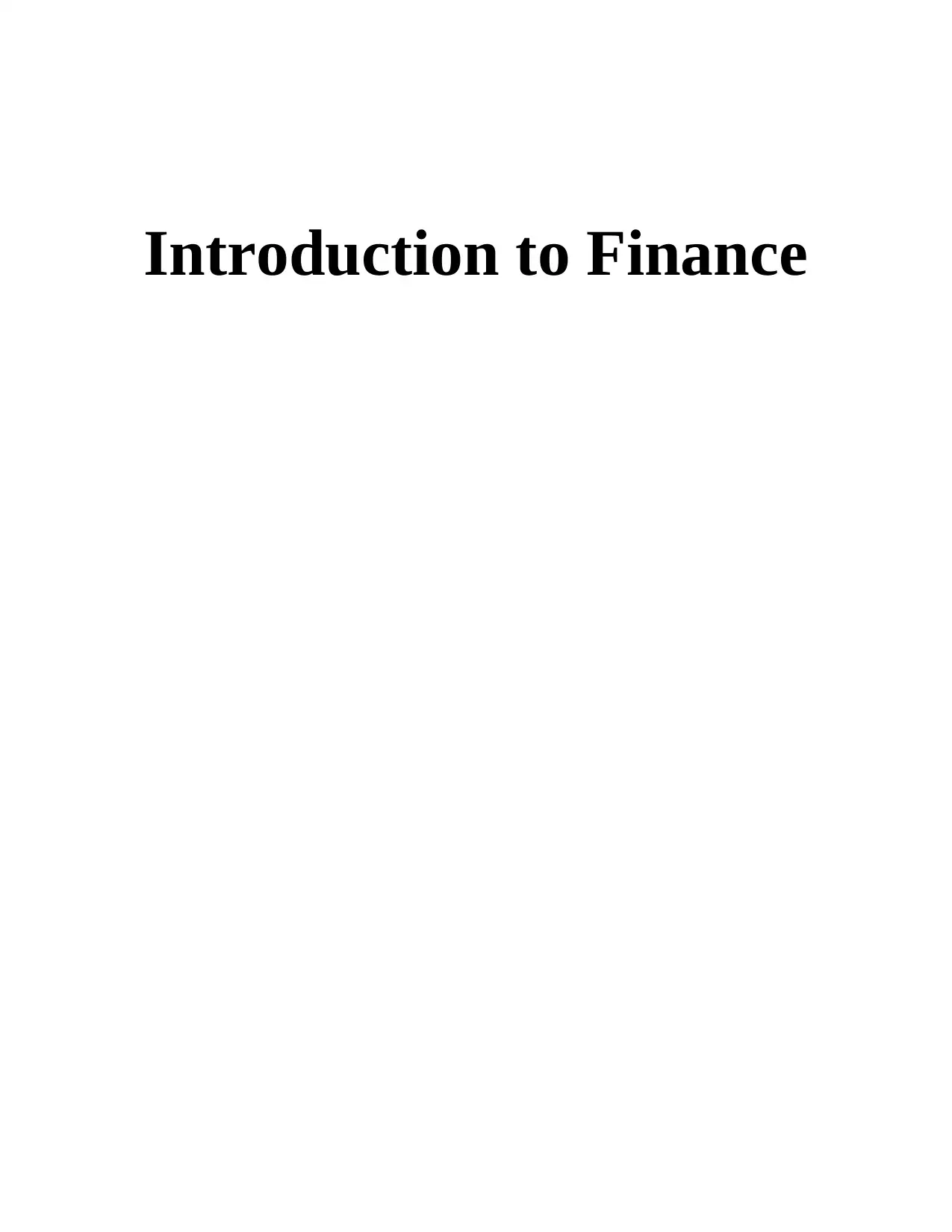
Introduction to Finance
Paraphrase This Document
Need a fresh take? Get an instant paraphrase of this document with our AI Paraphraser

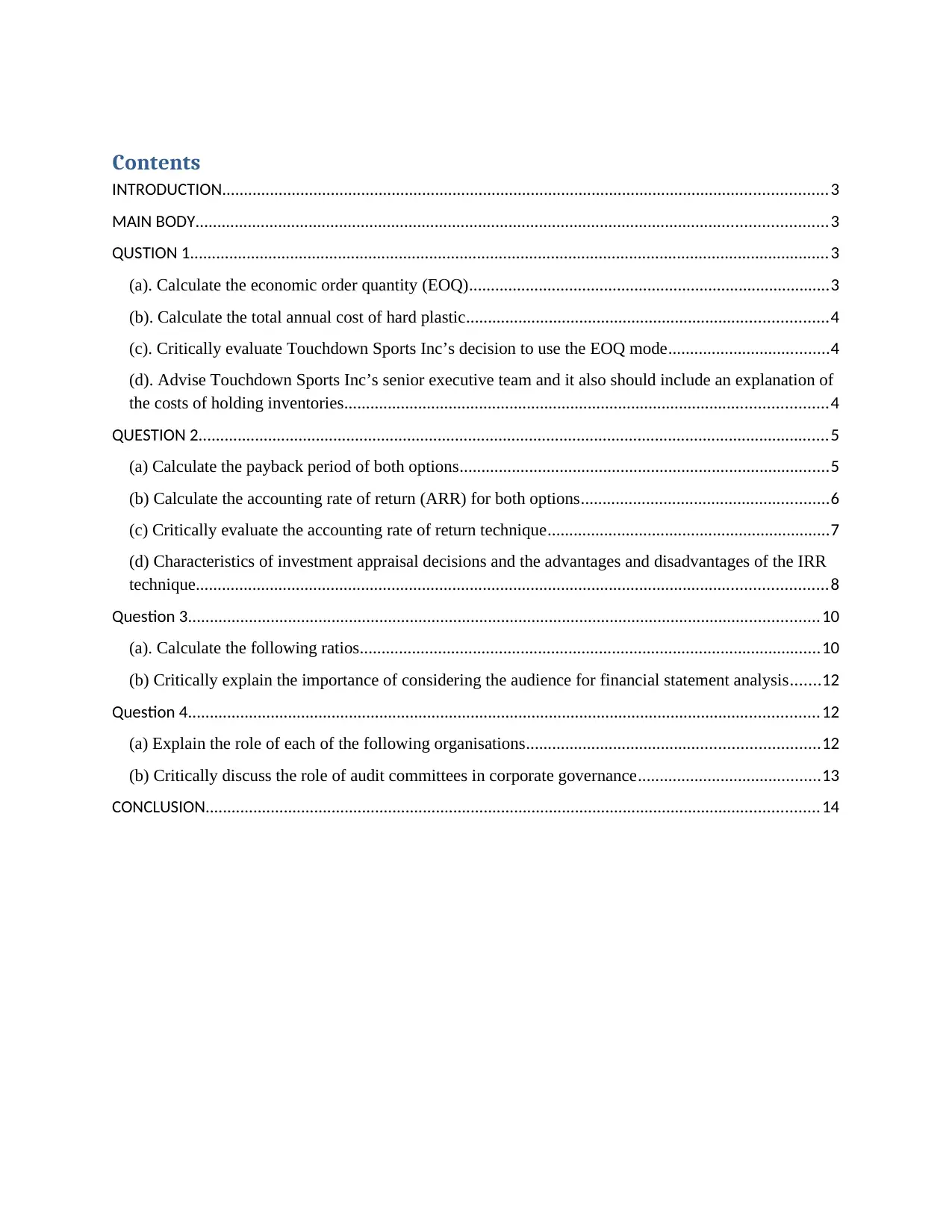
Contents
INTRODUCTION...........................................................................................................................................3
MAIN BODY.................................................................................................................................................3
QUSTION 1...................................................................................................................................................3
(a). Calculate the economic order quantity (EOQ)...................................................................................3
(b). Calculate the total annual cost of hard plastic...................................................................................4
(c). Critically evaluate Touchdown Sports Inc’s decision to use the EOQ mode.....................................4
(d). Advise Touchdown Sports Inc’s senior executive team and it also should include an explanation of
the costs of holding inventories...............................................................................................................4
QUESTION 2.................................................................................................................................................5
(a) Calculate the payback period of both options.....................................................................................5
(b) Calculate the accounting rate of return (ARR) for both options.........................................................6
(c) Critically evaluate the accounting rate of return technique.................................................................7
(d) Characteristics of investment appraisal decisions and the advantages and disadvantages of the IRR
technique.................................................................................................................................................8
Question 3.................................................................................................................................................10
(a). Calculate the following ratios..........................................................................................................10
(b) Critically explain the importance of considering the audience for financial statement analysis.......12
Question 4.................................................................................................................................................12
(a) Explain the role of each of the following organisations...................................................................12
(b) Critically discuss the role of audit committees in corporate governance..........................................13
CONCLUSION.............................................................................................................................................14
INTRODUCTION...........................................................................................................................................3
MAIN BODY.................................................................................................................................................3
QUSTION 1...................................................................................................................................................3
(a). Calculate the economic order quantity (EOQ)...................................................................................3
(b). Calculate the total annual cost of hard plastic...................................................................................4
(c). Critically evaluate Touchdown Sports Inc’s decision to use the EOQ mode.....................................4
(d). Advise Touchdown Sports Inc’s senior executive team and it also should include an explanation of
the costs of holding inventories...............................................................................................................4
QUESTION 2.................................................................................................................................................5
(a) Calculate the payback period of both options.....................................................................................5
(b) Calculate the accounting rate of return (ARR) for both options.........................................................6
(c) Critically evaluate the accounting rate of return technique.................................................................7
(d) Characteristics of investment appraisal decisions and the advantages and disadvantages of the IRR
technique.................................................................................................................................................8
Question 3.................................................................................................................................................10
(a). Calculate the following ratios..........................................................................................................10
(b) Critically explain the importance of considering the audience for financial statement analysis.......12
Question 4.................................................................................................................................................12
(a) Explain the role of each of the following organisations...................................................................12
(b) Critically discuss the role of audit committees in corporate governance..........................................13
CONCLUSION.............................................................................................................................................14
⊘ This is a preview!⊘
Do you want full access?
Subscribe today to unlock all pages.

Trusted by 1+ million students worldwide
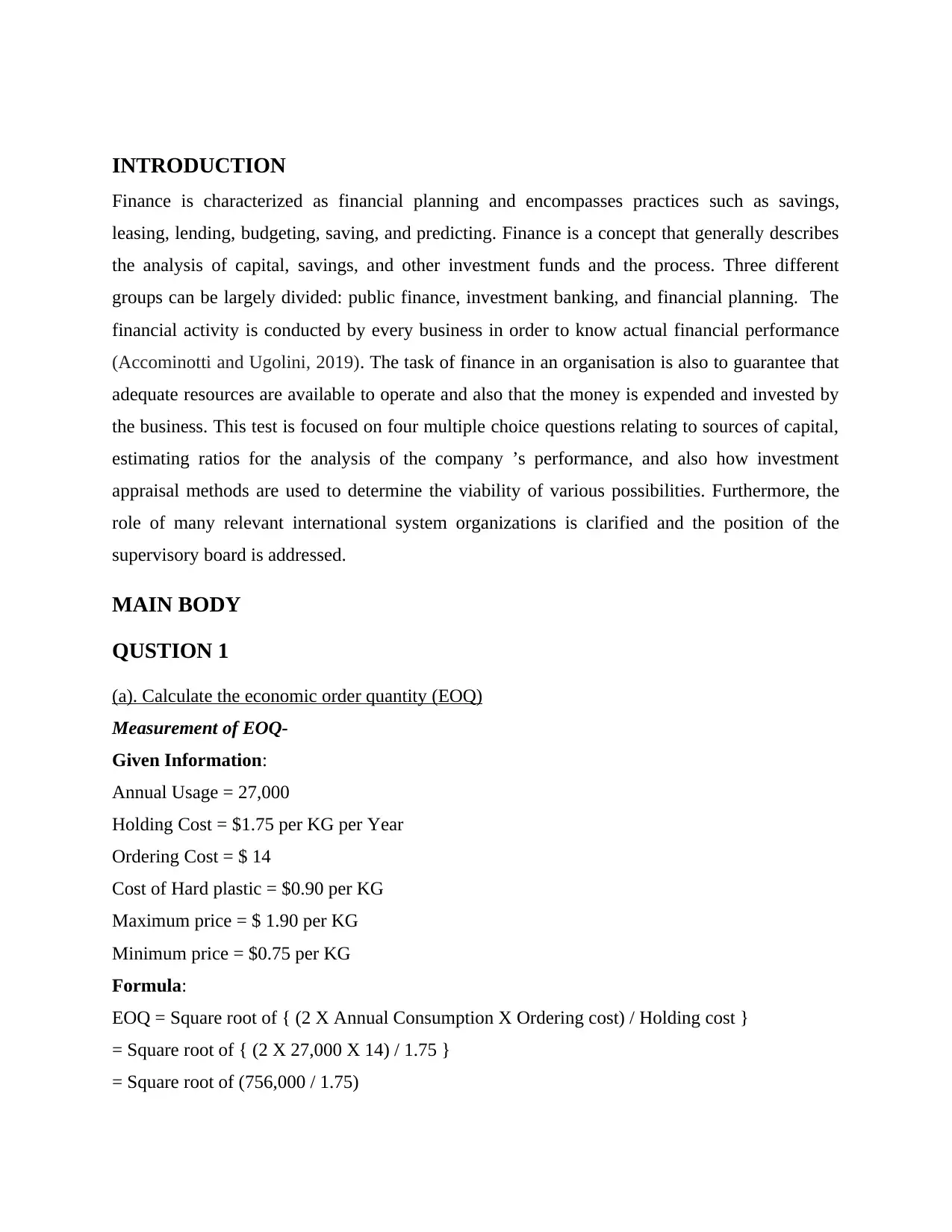
INTRODUCTION
Finance is characterized as financial planning and encompasses practices such as savings,
leasing, lending, budgeting, saving, and predicting. Finance is a concept that generally describes
the analysis of capital, savings, and other investment funds and the process. Three different
groups can be largely divided: public finance, investment banking, and financial planning. The
financial activity is conducted by every business in order to know actual financial performance
(Accominotti and Ugolini, 2019). The task of finance in an organisation is also to guarantee that
adequate resources are available to operate and also that the money is expended and invested by
the business. This test is focused on four multiple choice questions relating to sources of capital,
estimating ratios for the analysis of the company ’s performance, and also how investment
appraisal methods are used to determine the viability of various possibilities. Furthermore, the
role of many relevant international system organizations is clarified and the position of the
supervisory board is addressed.
MAIN BODY
QUSTION 1
(a). Calculate the economic order quantity (EOQ)
Measurement of EOQ-
Given Information:
Annual Usage = 27,000
Holding Cost = $1.75 per KG per Year
Ordering Cost = $ 14
Cost of Hard plastic = $0.90 per KG
Maximum price = $ 1.90 per KG
Minimum price = $0.75 per KG
Formula:
EOQ = Square root of { (2 X Annual Consumption X Ordering cost) / Holding cost }
= Square root of { (2 X 27,000 X 14) / 1.75 }
= Square root of (756,000 / 1.75)
Finance is characterized as financial planning and encompasses practices such as savings,
leasing, lending, budgeting, saving, and predicting. Finance is a concept that generally describes
the analysis of capital, savings, and other investment funds and the process. Three different
groups can be largely divided: public finance, investment banking, and financial planning. The
financial activity is conducted by every business in order to know actual financial performance
(Accominotti and Ugolini, 2019). The task of finance in an organisation is also to guarantee that
adequate resources are available to operate and also that the money is expended and invested by
the business. This test is focused on four multiple choice questions relating to sources of capital,
estimating ratios for the analysis of the company ’s performance, and also how investment
appraisal methods are used to determine the viability of various possibilities. Furthermore, the
role of many relevant international system organizations is clarified and the position of the
supervisory board is addressed.
MAIN BODY
QUSTION 1
(a). Calculate the economic order quantity (EOQ)
Measurement of EOQ-
Given Information:
Annual Usage = 27,000
Holding Cost = $1.75 per KG per Year
Ordering Cost = $ 14
Cost of Hard plastic = $0.90 per KG
Maximum price = $ 1.90 per KG
Minimum price = $0.75 per KG
Formula:
EOQ = Square root of { (2 X Annual Consumption X Ordering cost) / Holding cost }
= Square root of { (2 X 27,000 X 14) / 1.75 }
= Square root of (756,000 / 1.75)
Paraphrase This Document
Need a fresh take? Get an instant paraphrase of this document with our AI Paraphraser
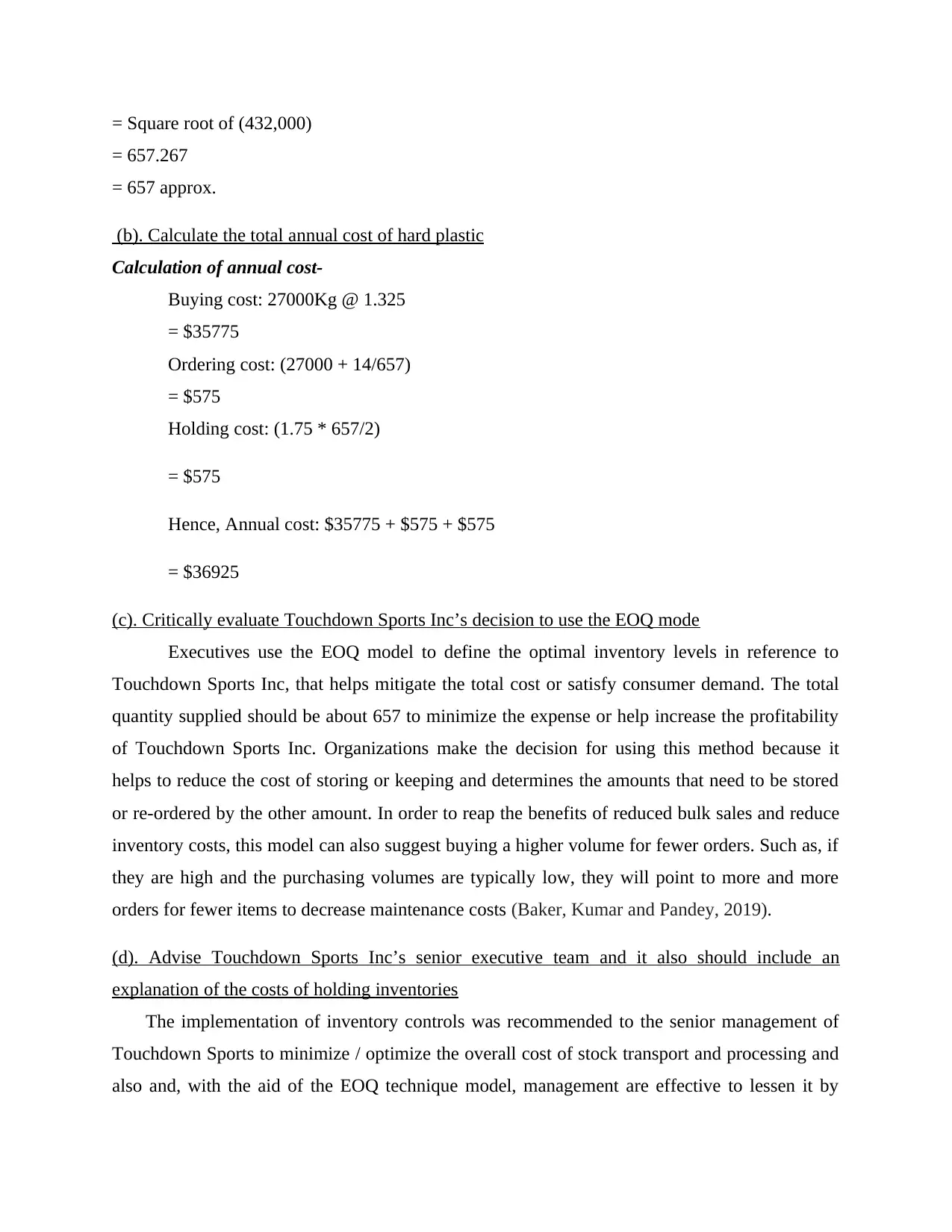
= Square root of (432,000)
= 657.267
= 657 approx.
(b). Calculate the total annual cost of hard plastic
Calculation of annual cost-
Buying cost: 27000Kg @ 1.325
= $35775
Ordering cost: (27000 + 14/657)
= $575
Holding cost: (1.75 * 657/2)
= $575
Hence, Annual cost: $35775 + $575 + $575
= $36925
(c). Critically evaluate Touchdown Sports Inc’s decision to use the EOQ mode
Executives use the EOQ model to define the optimal inventory levels in reference to
Touchdown Sports Inc, that helps mitigate the total cost or satisfy consumer demand. The total
quantity supplied should be about 657 to minimize the expense or help increase the profitability
of Touchdown Sports Inc. Organizations make the decision for using this method because it
helps to reduce the cost of storing or keeping and determines the amounts that need to be stored
or re-ordered by the other amount. In order to reap the benefits of reduced bulk sales and reduce
inventory costs, this model can also suggest buying a higher volume for fewer orders. Such as, if
they are high and the purchasing volumes are typically low, they will point to more and more
orders for fewer items to decrease maintenance costs (Baker, Kumar and Pandey, 2019).
(d). Advise Touchdown Sports Inc’s senior executive team and it also should include an
explanation of the costs of holding inventories
The implementation of inventory controls was recommended to the senior management of
Touchdown Sports to minimize / optimize the overall cost of stock transport and processing and
also and, with the aid of the EOQ technique model, management are effective to lessen it by
= 657.267
= 657 approx.
(b). Calculate the total annual cost of hard plastic
Calculation of annual cost-
Buying cost: 27000Kg @ 1.325
= $35775
Ordering cost: (27000 + 14/657)
= $575
Holding cost: (1.75 * 657/2)
= $575
Hence, Annual cost: $35775 + $575 + $575
= $36925
(c). Critically evaluate Touchdown Sports Inc’s decision to use the EOQ mode
Executives use the EOQ model to define the optimal inventory levels in reference to
Touchdown Sports Inc, that helps mitigate the total cost or satisfy consumer demand. The total
quantity supplied should be about 657 to minimize the expense or help increase the profitability
of Touchdown Sports Inc. Organizations make the decision for using this method because it
helps to reduce the cost of storing or keeping and determines the amounts that need to be stored
or re-ordered by the other amount. In order to reap the benefits of reduced bulk sales and reduce
inventory costs, this model can also suggest buying a higher volume for fewer orders. Such as, if
they are high and the purchasing volumes are typically low, they will point to more and more
orders for fewer items to decrease maintenance costs (Baker, Kumar and Pandey, 2019).
(d). Advise Touchdown Sports Inc’s senior executive team and it also should include an
explanation of the costs of holding inventories
The implementation of inventory controls was recommended to the senior management of
Touchdown Sports to minimize / optimize the overall cost of stock transport and processing and
also and, with the aid of the EOQ technique model, management are effective to lessen it by
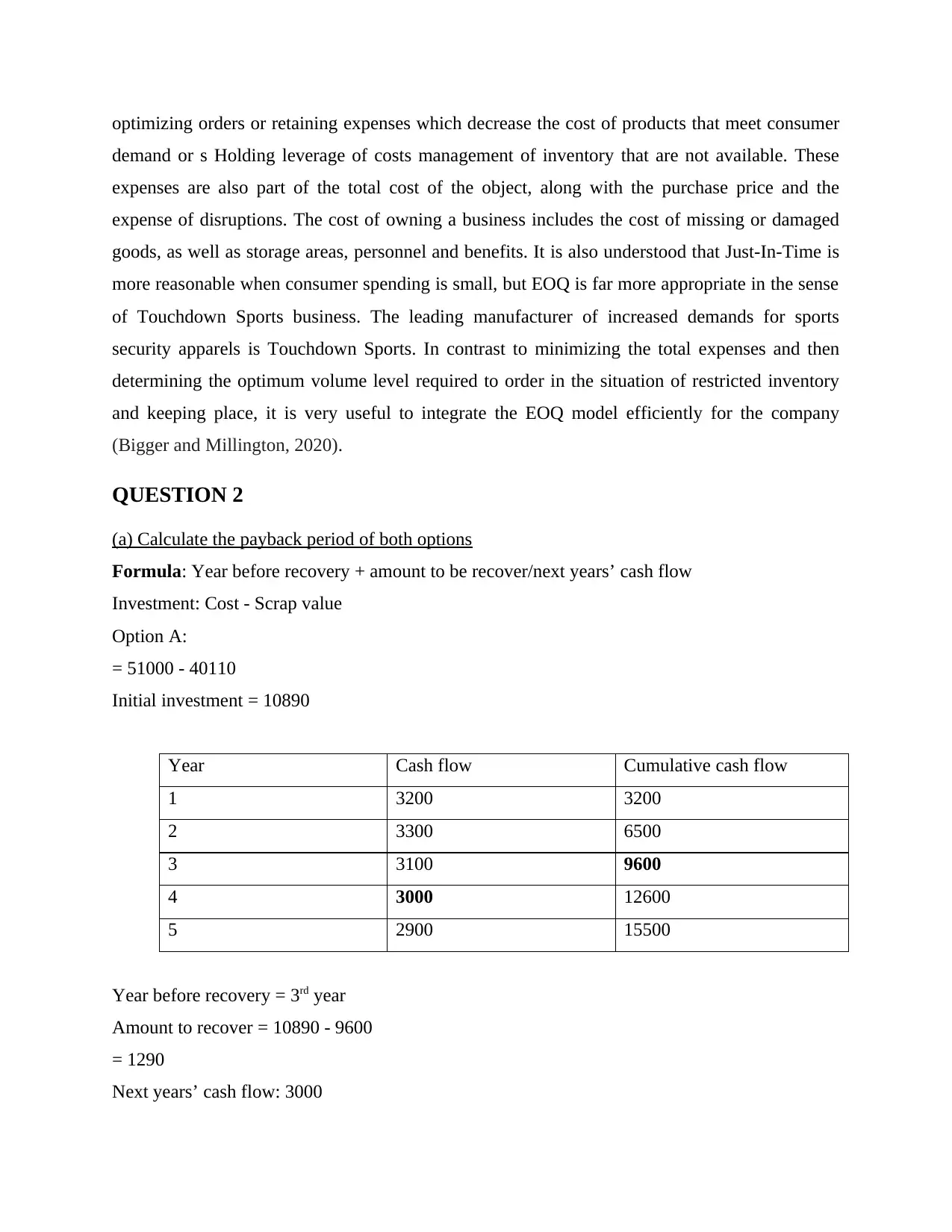
optimizing orders or retaining expenses which decrease the cost of products that meet consumer
demand or s Holding leverage of costs management of inventory that are not available. These
expenses are also part of the total cost of the object, along with the purchase price and the
expense of disruptions. The cost of owning a business includes the cost of missing or damaged
goods, as well as storage areas, personnel and benefits. It is also understood that Just-In-Time is
more reasonable when consumer spending is small, but EOQ is far more appropriate in the sense
of Touchdown Sports business. The leading manufacturer of increased demands for sports
security apparels is Touchdown Sports. In contrast to minimizing the total expenses and then
determining the optimum volume level required to order in the situation of restricted inventory
and keeping place, it is very useful to integrate the EOQ model efficiently for the company
(Bigger and Millington, 2020).
QUESTION 2
(a) Calculate the payback period of both options
Formula: Year before recovery + amount to be recover/next years’ cash flow
Investment: Cost - Scrap value
Option A:
= 51000 - 40110
Initial investment = 10890
Year Cash flow Cumulative cash flow
1 3200 3200
2 3300 6500
3 3100 9600
4 3000 12600
5 2900 15500
Year before recovery = 3rd year
Amount to recover = 10890 - 9600
= 1290
Next years’ cash flow: 3000
demand or s Holding leverage of costs management of inventory that are not available. These
expenses are also part of the total cost of the object, along with the purchase price and the
expense of disruptions. The cost of owning a business includes the cost of missing or damaged
goods, as well as storage areas, personnel and benefits. It is also understood that Just-In-Time is
more reasonable when consumer spending is small, but EOQ is far more appropriate in the sense
of Touchdown Sports business. The leading manufacturer of increased demands for sports
security apparels is Touchdown Sports. In contrast to minimizing the total expenses and then
determining the optimum volume level required to order in the situation of restricted inventory
and keeping place, it is very useful to integrate the EOQ model efficiently for the company
(Bigger and Millington, 2020).
QUESTION 2
(a) Calculate the payback period of both options
Formula: Year before recovery + amount to be recover/next years’ cash flow
Investment: Cost - Scrap value
Option A:
= 51000 - 40110
Initial investment = 10890
Year Cash flow Cumulative cash flow
1 3200 3200
2 3300 6500
3 3100 9600
4 3000 12600
5 2900 15500
Year before recovery = 3rd year
Amount to recover = 10890 - 9600
= 1290
Next years’ cash flow: 3000
⊘ This is a preview!⊘
Do you want full access?
Subscribe today to unlock all pages.

Trusted by 1+ million students worldwide
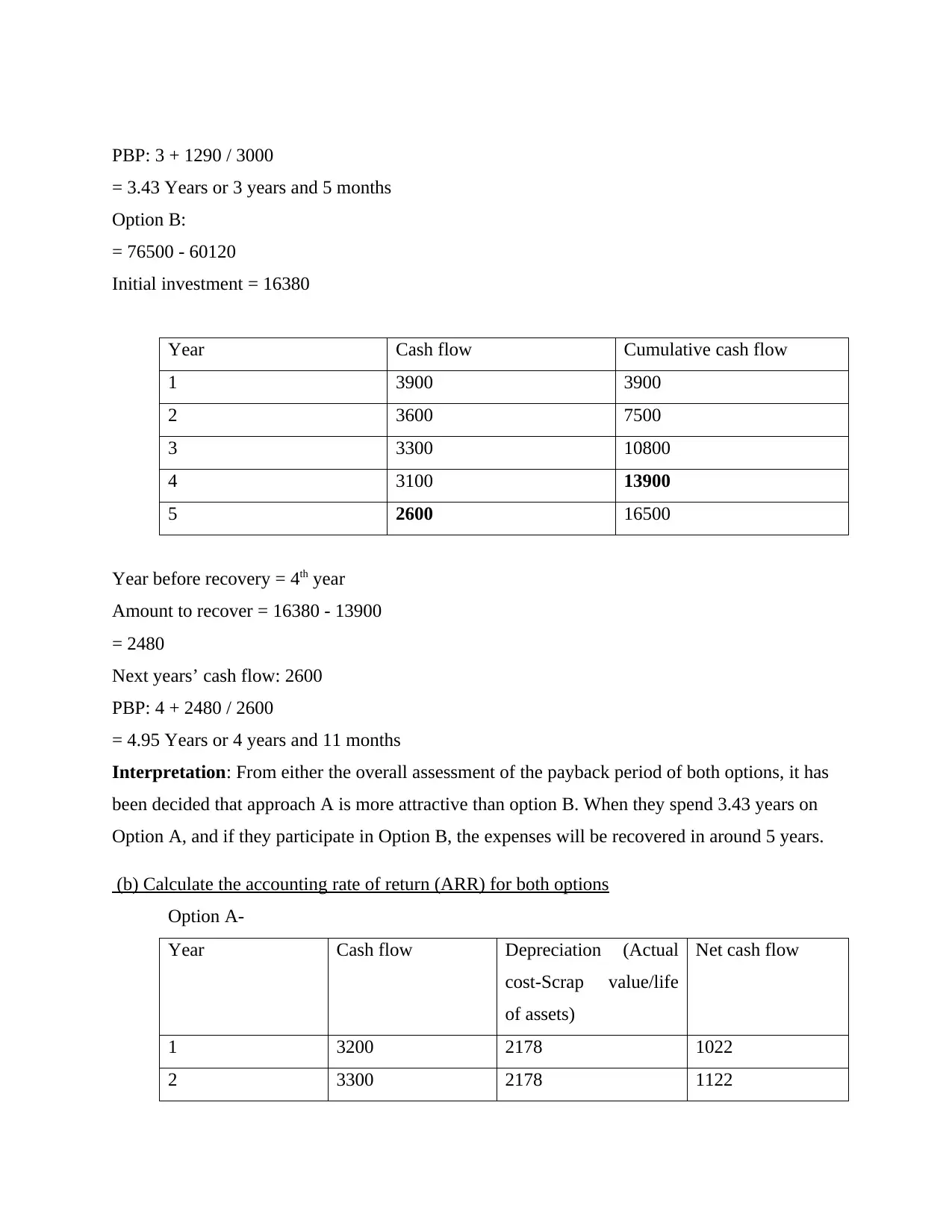
PBP: 3 + 1290 / 3000
= 3.43 Years or 3 years and 5 months
Option B:
= 76500 - 60120
Initial investment = 16380
Year Cash flow Cumulative cash flow
1 3900 3900
2 3600 7500
3 3300 10800
4 3100 13900
5 2600 16500
Year before recovery = 4th year
Amount to recover = 16380 - 13900
= 2480
Next years’ cash flow: 2600
PBP: 4 + 2480 / 2600
= 4.95 Years or 4 years and 11 months
Interpretation: From either the overall assessment of the payback period of both options, it has
been decided that approach A is more attractive than option B. When they spend 3.43 years on
Option A, and if they participate in Option B, the expenses will be recovered in around 5 years.
(b) Calculate the accounting rate of return (ARR) for both options
Option A-
Year Cash flow Depreciation (Actual
cost-Scrap value/life
of assets)
Net cash flow
1 3200 2178 1022
2 3300 2178 1122
= 3.43 Years or 3 years and 5 months
Option B:
= 76500 - 60120
Initial investment = 16380
Year Cash flow Cumulative cash flow
1 3900 3900
2 3600 7500
3 3300 10800
4 3100 13900
5 2600 16500
Year before recovery = 4th year
Amount to recover = 16380 - 13900
= 2480
Next years’ cash flow: 2600
PBP: 4 + 2480 / 2600
= 4.95 Years or 4 years and 11 months
Interpretation: From either the overall assessment of the payback period of both options, it has
been decided that approach A is more attractive than option B. When they spend 3.43 years on
Option A, and if they participate in Option B, the expenses will be recovered in around 5 years.
(b) Calculate the accounting rate of return (ARR) for both options
Option A-
Year Cash flow Depreciation (Actual
cost-Scrap value/life
of assets)
Net cash flow
1 3200 2178 1022
2 3300 2178 1122
Paraphrase This Document
Need a fresh take? Get an instant paraphrase of this document with our AI Paraphraser
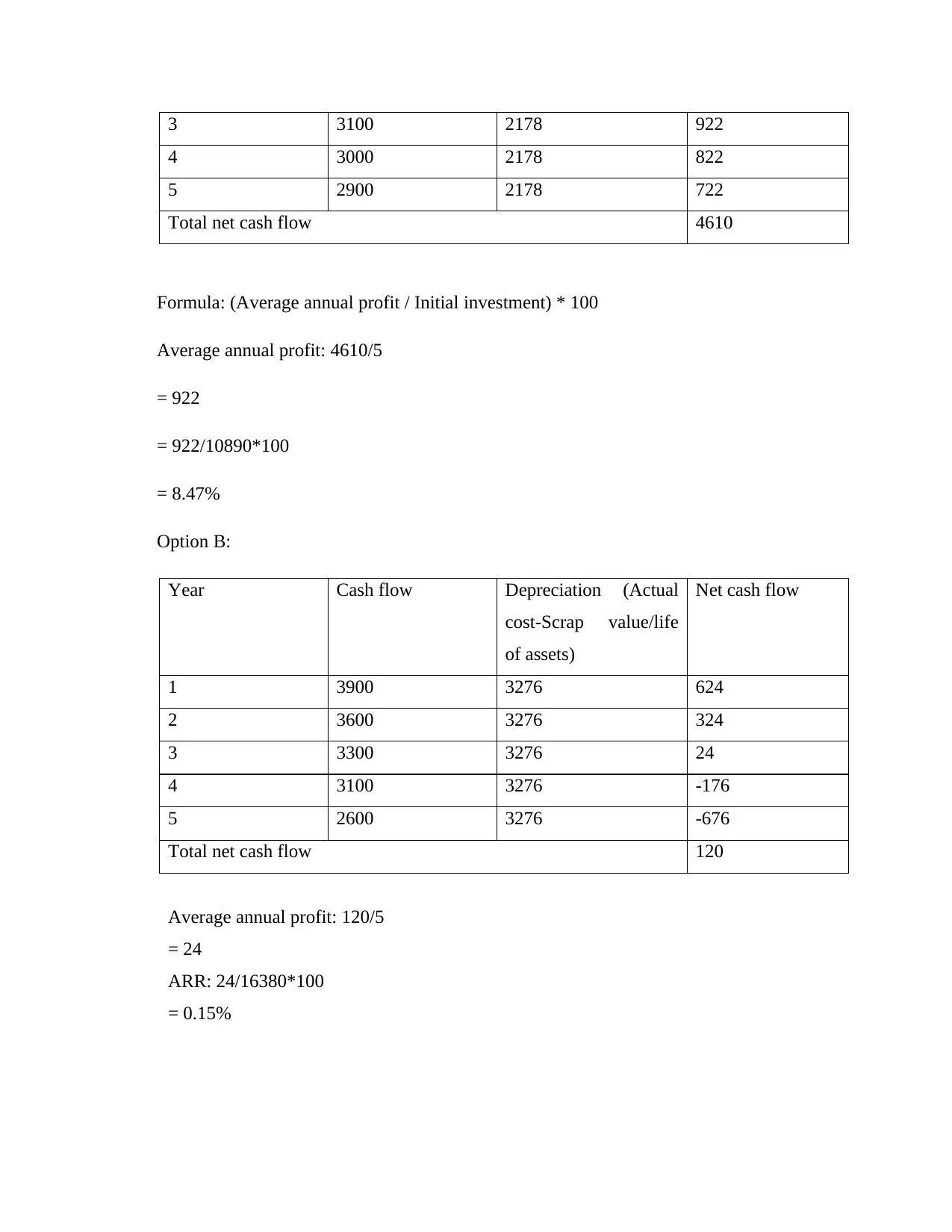
3 3100 2178 922
4 3000 2178 822
5 2900 2178 722
Total net cash flow 4610
Formula: (Average annual profit / Initial investment) * 100
Average annual profit: 4610/5
= 922
= 922/10890*100
= 8.47%
Option B:
Year Cash flow Depreciation (Actual
cost-Scrap value/life
of assets)
Net cash flow
1 3900 3276 624
2 3600 3276 324
3 3300 3276 24
4 3100 3276 -176
5 2600 3276 -676
Total net cash flow 120
Average annual profit: 120/5
= 24
ARR: 24/16380*100
= 0.15%
4 3000 2178 822
5 2900 2178 722
Total net cash flow 4610
Formula: (Average annual profit / Initial investment) * 100
Average annual profit: 4610/5
= 922
= 922/10890*100
= 8.47%
Option B:
Year Cash flow Depreciation (Actual
cost-Scrap value/life
of assets)
Net cash flow
1 3900 3276 624
2 3600 3276 324
3 3300 3276 24
4 3100 3276 -176
5 2600 3276 -676
Total net cash flow 120
Average annual profit: 120/5
= 24
ARR: 24/16380*100
= 0.15%
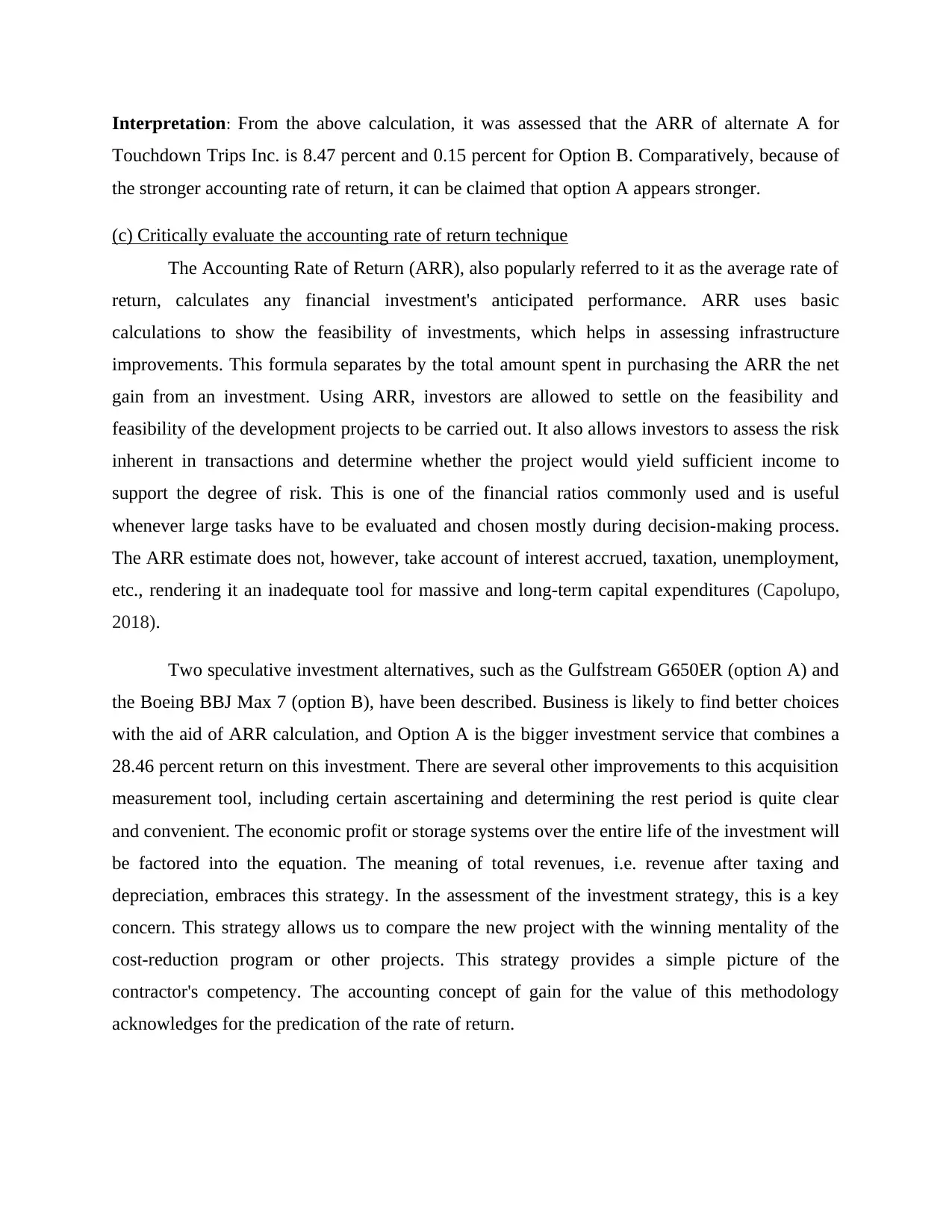
Interpretation: From the above calculation, it was assessed that the ARR of alternate A for
Touchdown Trips Inc. is 8.47 percent and 0.15 percent for Option B. Comparatively, because of
the stronger accounting rate of return, it can be claimed that option A appears stronger.
(c) Critically evaluate the accounting rate of return technique
The Accounting Rate of Return (ARR), also popularly referred to it as the average rate of
return, calculates any financial investment's anticipated performance. ARR uses basic
calculations to show the feasibility of investments, which helps in assessing infrastructure
improvements. This formula separates by the total amount spent in purchasing the ARR the net
gain from an investment. Using ARR, investors are allowed to settle on the feasibility and
feasibility of the development projects to be carried out. It also allows investors to assess the risk
inherent in transactions and determine whether the project would yield sufficient income to
support the degree of risk. This is one of the financial ratios commonly used and is useful
whenever large tasks have to be evaluated and chosen mostly during decision-making process.
The ARR estimate does not, however, take account of interest accrued, taxation, unemployment,
etc., rendering it an inadequate tool for massive and long-term capital expenditures (Capolupo,
2018).
Two speculative investment alternatives, such as the Gulfstream G650ER (option A) and
the Boeing BBJ Max 7 (option B), have been described. Business is likely to find better choices
with the aid of ARR calculation, and Option A is the bigger investment service that combines a
28.46 percent return on this investment. There are several other improvements to this acquisition
measurement tool, including certain ascertaining and determining the rest period is quite clear
and convenient. The economic profit or storage systems over the entire life of the investment will
be factored into the equation. The meaning of total revenues, i.e. revenue after taxing and
depreciation, embraces this strategy. In the assessment of the investment strategy, this is a key
concern. This strategy allows us to compare the new project with the winning mentality of the
cost-reduction program or other projects. This strategy provides a simple picture of the
contractor's competency. The accounting concept of gain for the value of this methodology
acknowledges for the predication of the rate of return.
Touchdown Trips Inc. is 8.47 percent and 0.15 percent for Option B. Comparatively, because of
the stronger accounting rate of return, it can be claimed that option A appears stronger.
(c) Critically evaluate the accounting rate of return technique
The Accounting Rate of Return (ARR), also popularly referred to it as the average rate of
return, calculates any financial investment's anticipated performance. ARR uses basic
calculations to show the feasibility of investments, which helps in assessing infrastructure
improvements. This formula separates by the total amount spent in purchasing the ARR the net
gain from an investment. Using ARR, investors are allowed to settle on the feasibility and
feasibility of the development projects to be carried out. It also allows investors to assess the risk
inherent in transactions and determine whether the project would yield sufficient income to
support the degree of risk. This is one of the financial ratios commonly used and is useful
whenever large tasks have to be evaluated and chosen mostly during decision-making process.
The ARR estimate does not, however, take account of interest accrued, taxation, unemployment,
etc., rendering it an inadequate tool for massive and long-term capital expenditures (Capolupo,
2018).
Two speculative investment alternatives, such as the Gulfstream G650ER (option A) and
the Boeing BBJ Max 7 (option B), have been described. Business is likely to find better choices
with the aid of ARR calculation, and Option A is the bigger investment service that combines a
28.46 percent return on this investment. There are several other improvements to this acquisition
measurement tool, including certain ascertaining and determining the rest period is quite clear
and convenient. The economic profit or storage systems over the entire life of the investment will
be factored into the equation. The meaning of total revenues, i.e. revenue after taxing and
depreciation, embraces this strategy. In the assessment of the investment strategy, this is a key
concern. This strategy allows us to compare the new project with the winning mentality of the
cost-reduction program or other projects. This strategy provides a simple picture of the
contractor's competency. The accounting concept of gain for the value of this methodology
acknowledges for the predication of the rate of return.
⊘ This is a preview!⊘
Do you want full access?
Subscribe today to unlock all pages.

Trusted by 1+ million students worldwide
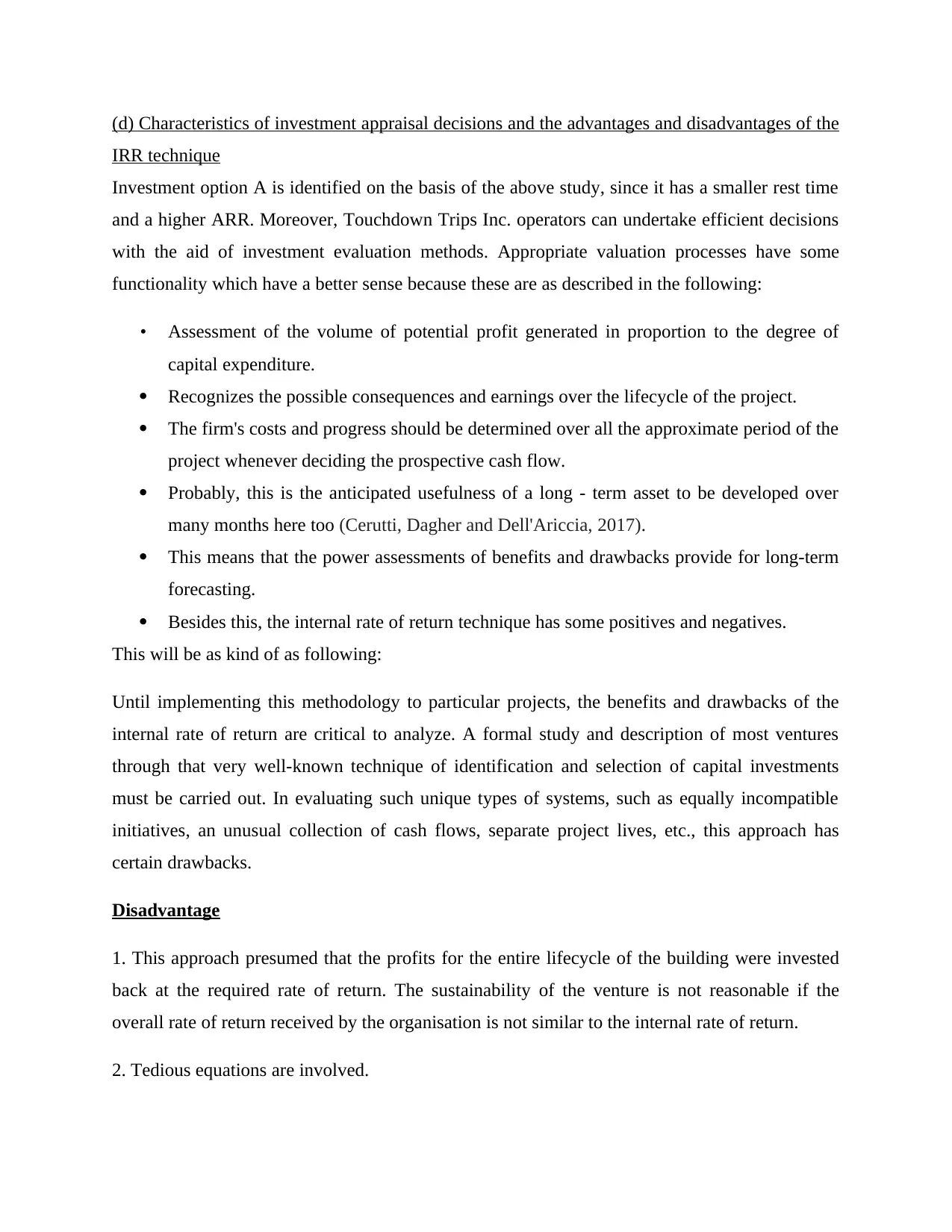
(d) Characteristics of investment appraisal decisions and the advantages and disadvantages of the
IRR technique
Investment option A is identified on the basis of the above study, since it has a smaller rest time
and a higher ARR. Moreover, Touchdown Trips Inc. operators can undertake efficient decisions
with the aid of investment evaluation methods. Appropriate valuation processes have some
functionality which have a better sense because these are as described in the following:
• Assessment of the volume of potential profit generated in proportion to the degree of
capital expenditure.
Recognizes the possible consequences and earnings over the lifecycle of the project.
The firm's costs and progress should be determined over all the approximate period of the
project whenever deciding the prospective cash flow.
Probably, this is the anticipated usefulness of a long - term asset to be developed over
many months here too (Cerutti, Dagher and Dell'Ariccia, 2017).
This means that the power assessments of benefits and drawbacks provide for long-term
forecasting.
Besides this, the internal rate of return technique has some positives and negatives.
This will be as kind of as following:
Until implementing this methodology to particular projects, the benefits and drawbacks of the
internal rate of return are critical to analyze. A formal study and description of most ventures
through that very well-known technique of identification and selection of capital investments
must be carried out. In evaluating such unique types of systems, such as equally incompatible
initiatives, an unusual collection of cash flows, separate project lives, etc., this approach has
certain drawbacks.
Disadvantage
1. This approach presumed that the profits for the entire lifecycle of the building were invested
back at the required rate of return. The sustainability of the venture is not reasonable if the
overall rate of return received by the organisation is not similar to the internal rate of return.
2. Tedious equations are involved.
IRR technique
Investment option A is identified on the basis of the above study, since it has a smaller rest time
and a higher ARR. Moreover, Touchdown Trips Inc. operators can undertake efficient decisions
with the aid of investment evaluation methods. Appropriate valuation processes have some
functionality which have a better sense because these are as described in the following:
• Assessment of the volume of potential profit generated in proportion to the degree of
capital expenditure.
Recognizes the possible consequences and earnings over the lifecycle of the project.
The firm's costs and progress should be determined over all the approximate period of the
project whenever deciding the prospective cash flow.
Probably, this is the anticipated usefulness of a long - term asset to be developed over
many months here too (Cerutti, Dagher and Dell'Ariccia, 2017).
This means that the power assessments of benefits and drawbacks provide for long-term
forecasting.
Besides this, the internal rate of return technique has some positives and negatives.
This will be as kind of as following:
Until implementing this methodology to particular projects, the benefits and drawbacks of the
internal rate of return are critical to analyze. A formal study and description of most ventures
through that very well-known technique of identification and selection of capital investments
must be carried out. In evaluating such unique types of systems, such as equally incompatible
initiatives, an unusual collection of cash flows, separate project lives, etc., this approach has
certain drawbacks.
Disadvantage
1. This approach presumed that the profits for the entire lifecycle of the building were invested
back at the required rate of return. The sustainability of the venture is not reasonable if the
overall rate of return received by the organisation is not similar to the internal rate of return.
2. Tedious equations are involved.
Paraphrase This Document
Need a fresh take? Get an instant paraphrase of this document with our AI Paraphraser
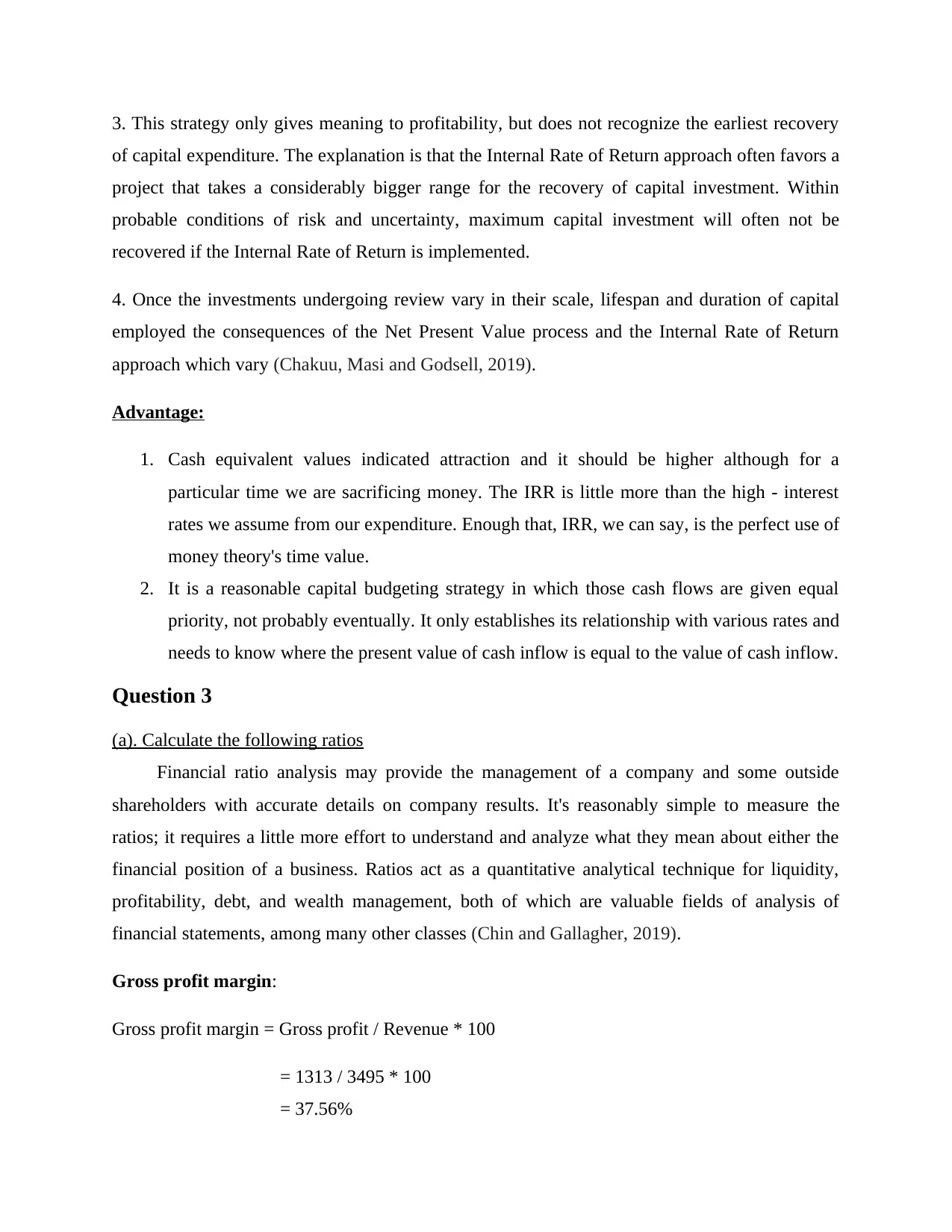
3. This strategy only gives meaning to profitability, but does not recognize the earliest recovery
of capital expenditure. The explanation is that the Internal Rate of Return approach often favors a
project that takes a considerably bigger range for the recovery of capital investment. Within
probable conditions of risk and uncertainty, maximum capital investment will often not be
recovered if the Internal Rate of Return is implemented.
4. Once the investments undergoing review vary in their scale, lifespan and duration of capital
employed the consequences of the Net Present Value process and the Internal Rate of Return
approach which vary (Chakuu, Masi and Godsell, 2019).
Advantage:
1. Cash equivalent values indicated attraction and it should be higher although for a
particular time we are sacrificing money. The IRR is little more than the high - interest
rates we assume from our expenditure. Enough that, IRR, we can say, is the perfect use of
money theory's time value.
2. It is a reasonable capital budgeting strategy in which those cash flows are given equal
priority, not probably eventually. It only establishes its relationship with various rates and
needs to know where the present value of cash inflow is equal to the value of cash inflow.
Question 3
(a). Calculate the following ratios
Financial ratio analysis may provide the management of a company and some outside
shareholders with accurate details on company results. It's reasonably simple to measure the
ratios; it requires a little more effort to understand and analyze what they mean about either the
financial position of a business. Ratios act as a quantitative analytical technique for liquidity,
profitability, debt, and wealth management, both of which are valuable fields of analysis of
financial statements, among many other classes (Chin and Gallagher, 2019).
Gross profit margin:
Gross profit margin = Gross profit / Revenue * 100
= 1313 / 3495 * 100
= 37.56%
of capital expenditure. The explanation is that the Internal Rate of Return approach often favors a
project that takes a considerably bigger range for the recovery of capital investment. Within
probable conditions of risk and uncertainty, maximum capital investment will often not be
recovered if the Internal Rate of Return is implemented.
4. Once the investments undergoing review vary in their scale, lifespan and duration of capital
employed the consequences of the Net Present Value process and the Internal Rate of Return
approach which vary (Chakuu, Masi and Godsell, 2019).
Advantage:
1. Cash equivalent values indicated attraction and it should be higher although for a
particular time we are sacrificing money. The IRR is little more than the high - interest
rates we assume from our expenditure. Enough that, IRR, we can say, is the perfect use of
money theory's time value.
2. It is a reasonable capital budgeting strategy in which those cash flows are given equal
priority, not probably eventually. It only establishes its relationship with various rates and
needs to know where the present value of cash inflow is equal to the value of cash inflow.
Question 3
(a). Calculate the following ratios
Financial ratio analysis may provide the management of a company and some outside
shareholders with accurate details on company results. It's reasonably simple to measure the
ratios; it requires a little more effort to understand and analyze what they mean about either the
financial position of a business. Ratios act as a quantitative analytical technique for liquidity,
profitability, debt, and wealth management, both of which are valuable fields of analysis of
financial statements, among many other classes (Chin and Gallagher, 2019).
Gross profit margin:
Gross profit margin = Gross profit / Revenue * 100
= 1313 / 3495 * 100
= 37.56%
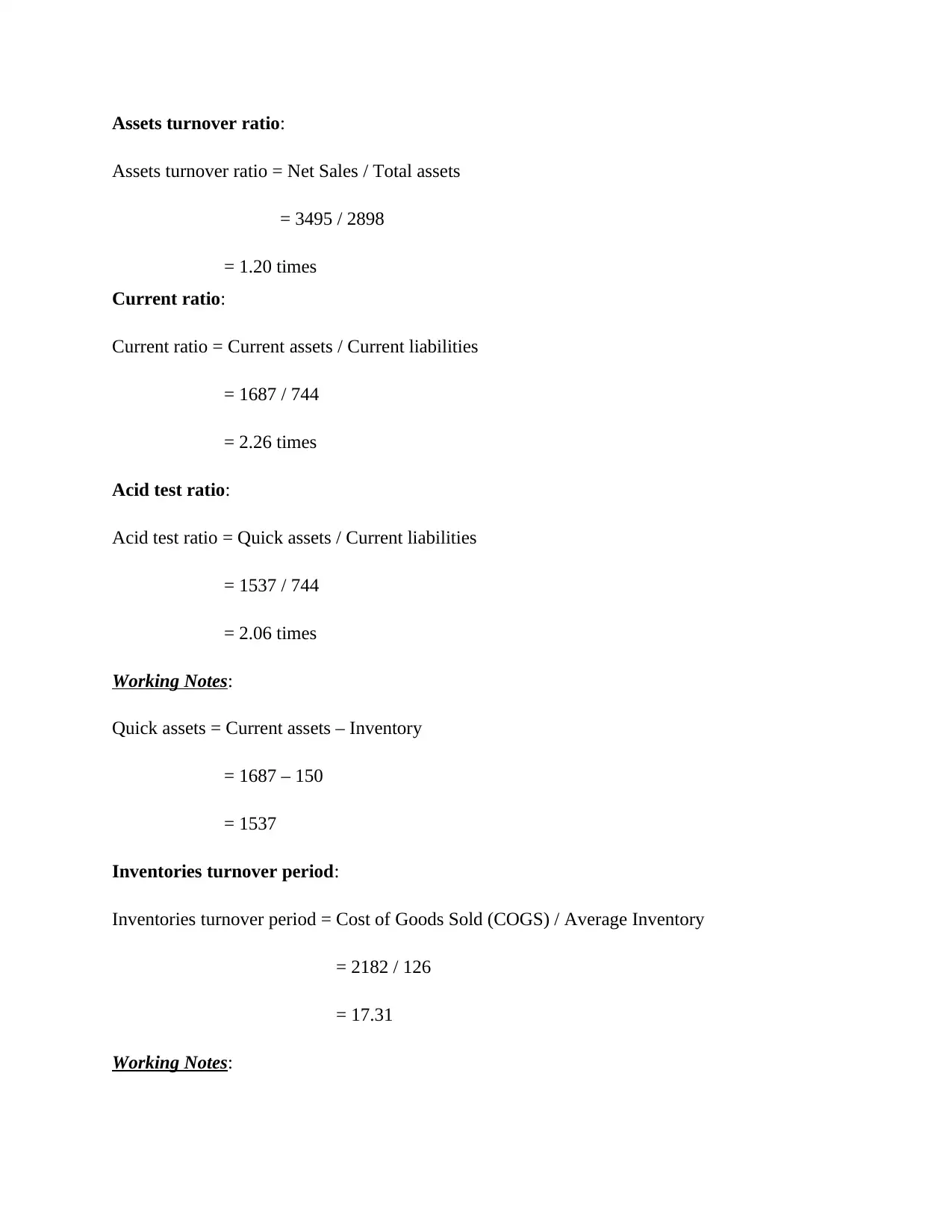
Assets turnover ratio:
Assets turnover ratio = Net Sales / Total assets
= 3495 / 2898
= 1.20 times
Current ratio:
Current ratio = Current assets / Current liabilities
= 1687 / 744
= 2.26 times
Acid test ratio:
Acid test ratio = Quick assets / Current liabilities
= 1537 / 744
= 2.06 times
Working Notes:
Quick assets = Current assets – Inventory
= 1687 – 150
= 1537
Inventories turnover period:
Inventories turnover period = Cost of Goods Sold (COGS) / Average Inventory
= 2182 / 126
= 17.31
Working Notes:
Assets turnover ratio = Net Sales / Total assets
= 3495 / 2898
= 1.20 times
Current ratio:
Current ratio = Current assets / Current liabilities
= 1687 / 744
= 2.26 times
Acid test ratio:
Acid test ratio = Quick assets / Current liabilities
= 1537 / 744
= 2.06 times
Working Notes:
Quick assets = Current assets – Inventory
= 1687 – 150
= 1537
Inventories turnover period:
Inventories turnover period = Cost of Goods Sold (COGS) / Average Inventory
= 2182 / 126
= 17.31
Working Notes:
⊘ This is a preview!⊘
Do you want full access?
Subscribe today to unlock all pages.

Trusted by 1+ million students worldwide
1 out of 16
Related Documents
Your All-in-One AI-Powered Toolkit for Academic Success.
+13062052269
info@desklib.com
Available 24*7 on WhatsApp / Email
![[object Object]](/_next/static/media/star-bottom.7253800d.svg)
Unlock your academic potential
Copyright © 2020–2025 A2Z Services. All Rights Reserved. Developed and managed by ZUCOL.




